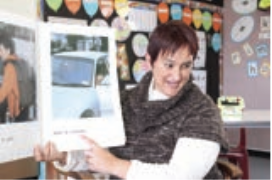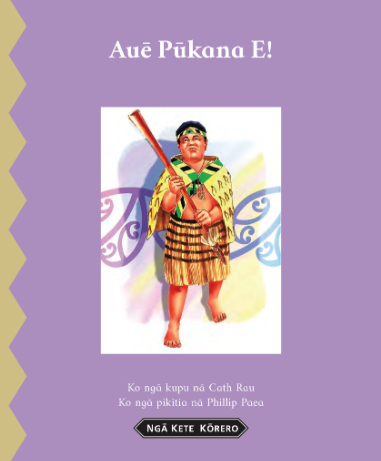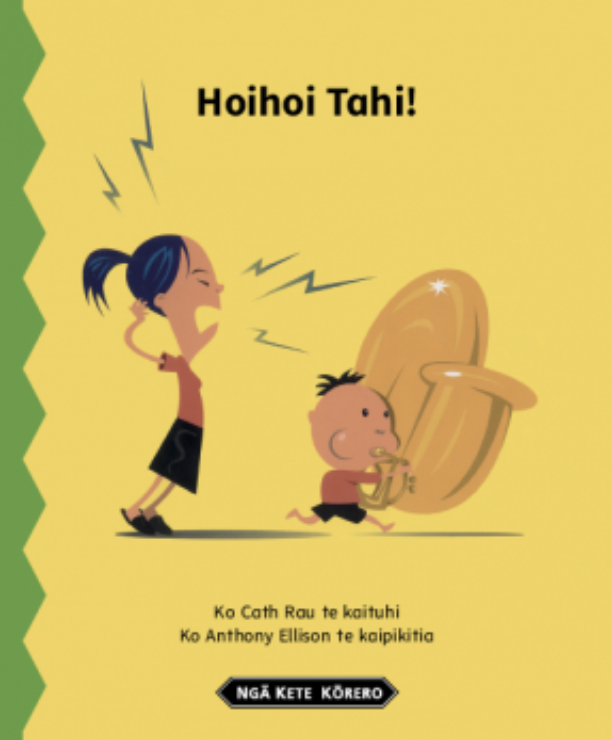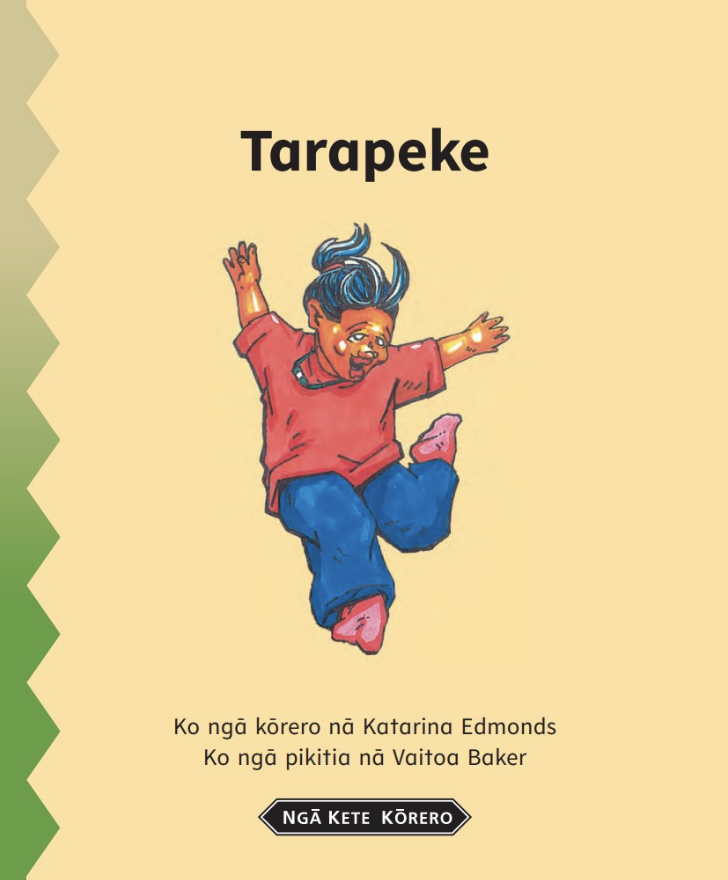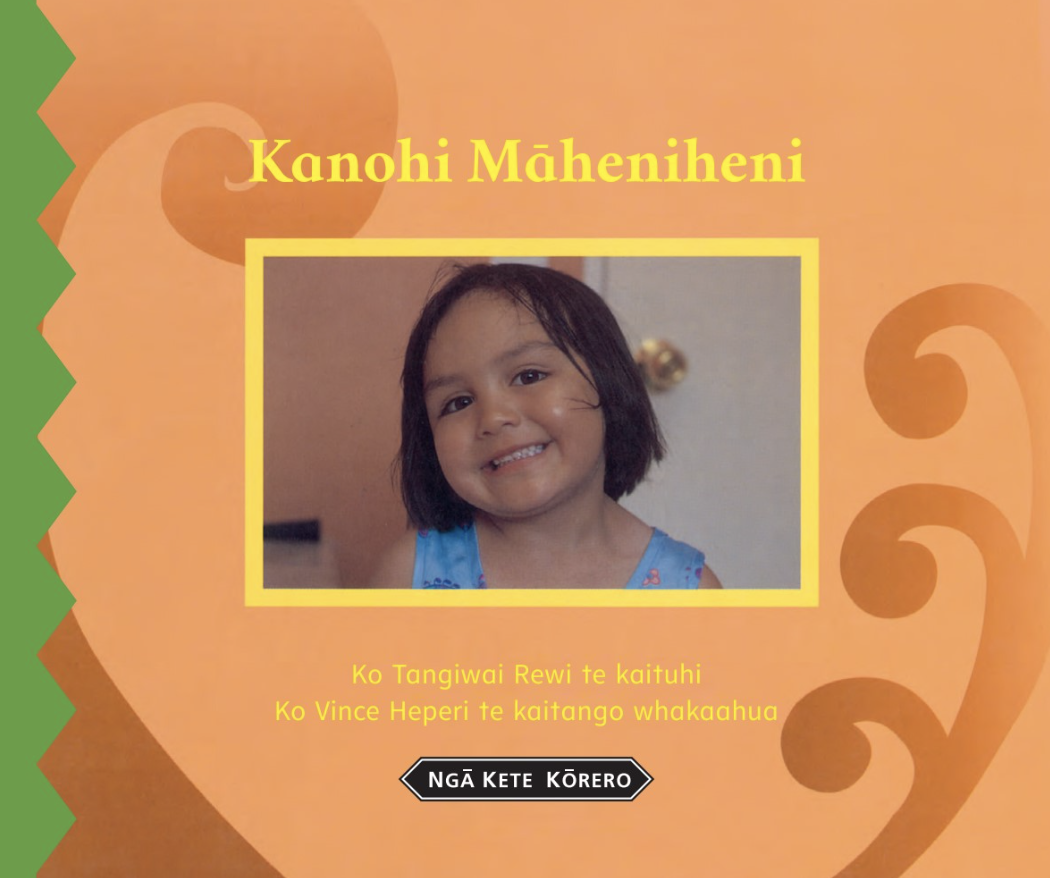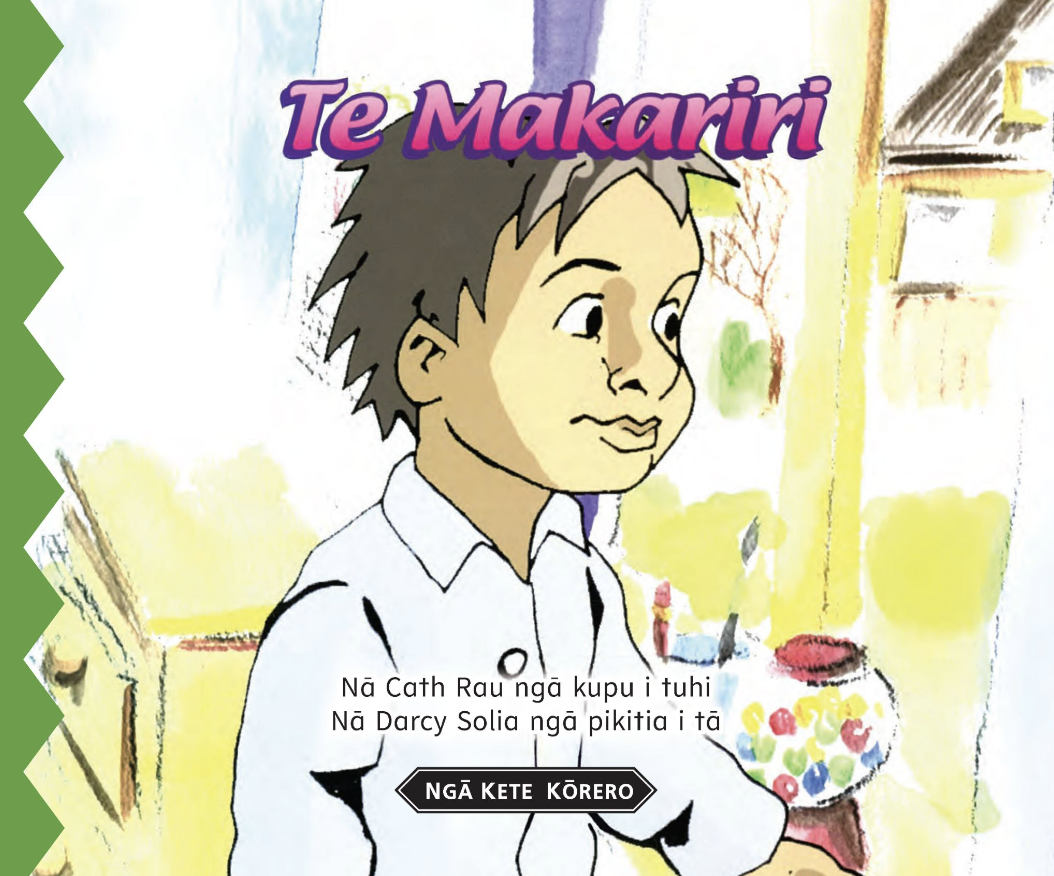I TE TAU TUATAHI
TE ARA WHAKAAKO I TE PĀNUI
Whārangi Ihirangi
Mātua ko te Kōtuitui
Kaiako should explicitly plan to integrate the language strands, whakarongo, kōrero, pānui, tuhituhi, mātakitaki and whakaatu.
Language competency is critical for ākonga to successfully access the curriculum and learning that is relevant to their world.
It is important to make connections across the curriculum between prior knowledge and new knowledge by providing a range of stimulating and engaging experiences.
I te tau tuatahi: Te Ara Whakaako i te Pānui
Te whakamāramatanga me ngā āhuatanga
PĀNUI NGĀTAHI | SHARED READING
Pānui Ngātahi should be used as the primary instructional approach.
Pānui Ngātahi is a collaborative reading experience where a kaiako and a group of ākonga read a text together which they may revisit over consecutive days. The kaiako typically reads aloud, modelling fluent reading, while ākonga read along where they can. The focus is on shared interaction between the kaiako and ākonga, and between ākonga, where connections with the text to prior knowledge are made.
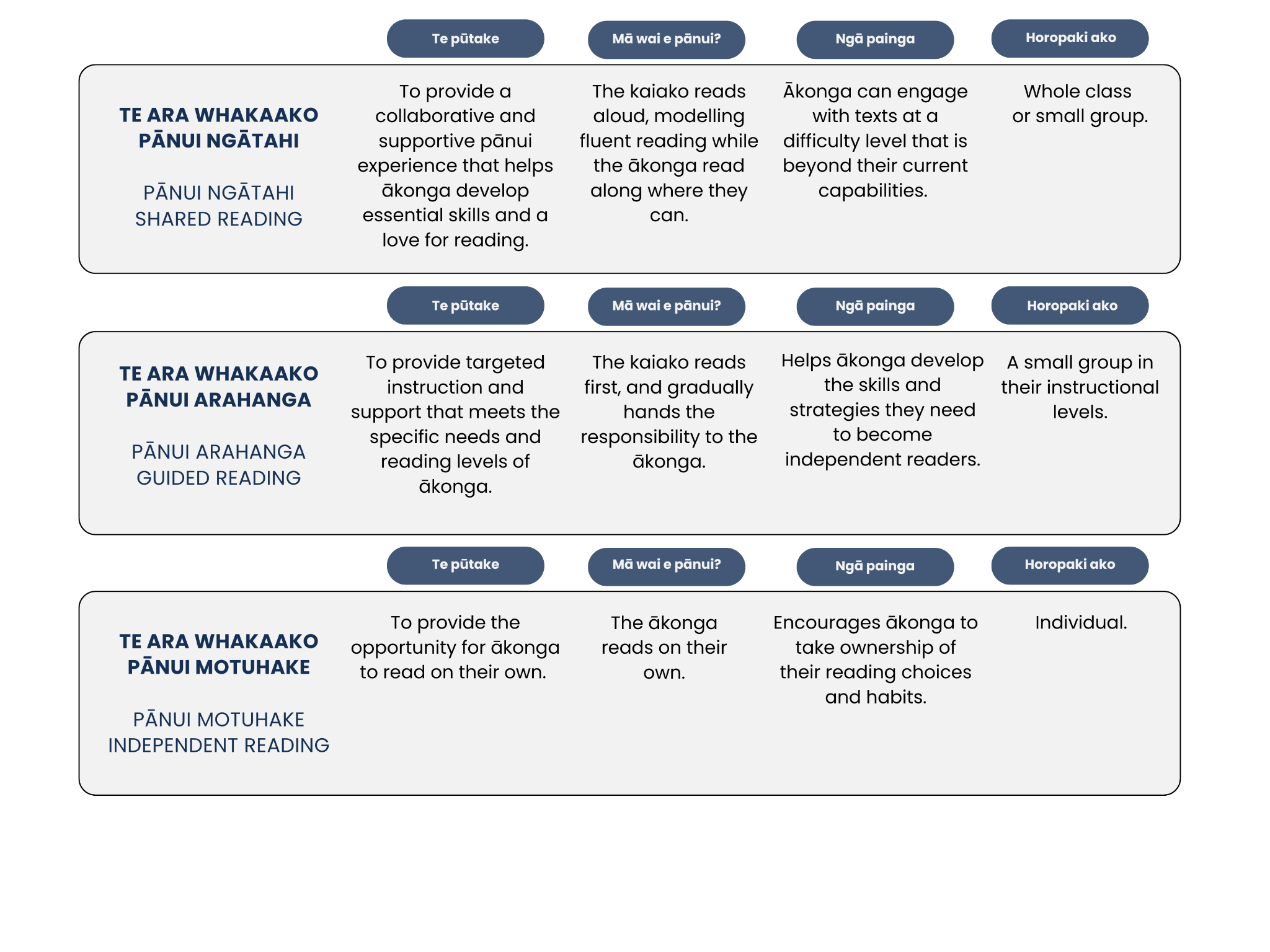
I te tau tuatahi: Te Whakahaere i te Pānui Ngātahi
Kura: Nawton School
Kaiako: Lisa Hopa
Taumata: Tau 0–1
He akoranga Pānui Ngātahi tēnei e aro atu ana ki ngā tikanga tuhituhi me te hanganga o te pukapuka.
Transcript
[Pouako ki ngā mokopuna]
Anei tō tātou whāinga i tēnei ata. Titiro. E ako ana mātou i ngā tikanga o te tuhituhi, arā, te uwhi o mua, te uwhi o muri, te tapanga, te taitara rānei, te tuara o te pukapuka. Kei te pai tērā?
Āe. [mokopuna]
[Pouako]
Ki ahau nei, he pai ngā mea … ngā pukapuka rahi. Kia māmā te kite mō ngā tamariki, te kite i te āhuatanga o te tuhituhi, ā… te ātaahua hoki o ngā pikitia. Me te mea nei, ā, ngā pukapuka ngākaunui ki a rātou.
[Pouako me ngā mokopuna]
Kua rite tātou ki te pānui tēnei pukapuka?
Kāo. Huri te pukapuka.
Nē, me huri a Whaea Lisa i te pukapuka?
Āe.
Haere anō.
Kua rite a Whaea Lisa ki te pānui te pukapuka i tēnei wā?
Kāo.
He aha Charlie? He aha te raru?
[Pouako]
Mō ngā pīpī paopao, ko te whāinga ki a au ngā momo āhuatanga o te pukapuka. Te uwhi o mua, te uwhi o muri.
[Pouako me ngā mokopuna]
Me tīmata anō a Whaea Lisa? Āe. Me huri te pukapuka? Āe!
Ara! Kua tīmata a Whaea Lisa ki te...
Huri anō!
Nē, i huri a Whaea Lisa i te pukapuka.
...pēnei. ...tēnei
Kāo.
Me huri anō?
Āe.
[Pouako]
Ka āta titiro ki ngā ira kati, ngā tohu kōrero pērā i te ira kati, ki ngā tohu pātai, ērā momo. Ka tīmata tātou ki whea? … ērā momo āhuatanga e pā ana ki te pānui.
[Pouako me ngā mokopuna]
Pēhea koe ka mōhio ko tērā te tapanga?
Nō te mea i tīmata i te …. ‘t’.
I te ‘t’? Āe. He tohu anō kia mōhio ai koe he tapanga tēnei?
Kāo.
Te āhua nei he tino n … nui. Tino nui te tuhituhi, nē rā.
Āe.
Te Taniwha me te Poraka.
Me tīmata a Whaea Lisa ki te pānui i whea? Tū mai tō ringa mehemea ka mōhio, tohu atu. Tohua, ka tīmata a Whaea Lisa ki te pānui ki whea?
[Pouako]
I tēnei wā ka ū tonu ahau ki te pukapuka, engari, ka mōhio au ka aro ētahi ki te rotarota, ngā waiata … Mehemea e hāngai ana ērā, ngā waiata ki te kaupapa matua, he kaha mātou ki te … ki te āta titiro ki ngā …ki ngā waiata e hāngai ana ki tō tātou rohe, ērā momo. Ka āta titiro ki ngā kupu kaumātua pea ka puta mai i roto i ngā pepeha, ngā whakataukī.
[Pouako me ngā mokopuna]
Nā wai i kī “uaka!”?
Ko te poraka.
Nē. Titiro ki te āhua o te taniwha. Kei te pōuri ia? Te taniwha? Nē? Kei te mataku ia i te aha?
Te poraka.
Nē … Kia tūpato Taniwha. Kei muri te poraka i a koe. Kia tere te kauhoe atu! Ka pai.
[Pouako]
He maha ngā mahi mō te kaiako hei whakarite mō te pānui tahi. Te nuinga o te wā ka whakaritehia he rauemi. Mehemea e hiahia ana kia ātaahua ngā rauemi, ka kapi mā te pukapuka ka whakapiri ki tētahi kāri kia pai ake. Kia taea e ngā tamariki te mahi anō i roto i ō rātou ake wā.
[Pouako me ngā mokopuna]
E tū harakeke. Kua rite tātou? Kei te mau tō kanohi poraka? Āe. Kia tūpato Poraka kei muri te taniwha i te harakeke. E peke, kia tere!
[Pouako]
E kaha ana ahau ki te kimi i te pukapuka e ngākaunui ana ki ngā tamariki. Mehemea he ngākaunui te pukapuka ki a rātou he māmā noa iho ki (mā)a rātou te whakautu pātai ki a koe. He maha ngā pukapuka pērā, i nāianei i te kura. Ki taku nei titiro, he tino pai ki a rātou ngā tamariki ki te rāwekeweke i ngā rauemi kia kore ai e maroke te mahi … kia kore e tuhituhi anake te mahi … ka taea e rātou te raweke hoki i ngā mahi hei āwhina i a rātou ki te oti pai i te whāinga o te mahi. Ki ahau nei he tino pai ngā (te) mahi whakaari ki a rātou, ngā tamariki. He tino whetū amorangi rātou.
[Hamahama waiata]
I te tau tuatahi: Ngā Pukapuka hei kawe i te Pānui Ngātahi
Print is organised, clearly formatted and distinguishable from illustrations, pictures or diagrams.
Examples:
Pictures, illustrations, diagrams strongly support the text and provide contextual clues:
That facilitate meaning making in general.
For predicting and confirming the meaning of unknown words.
Examples:
Extra spacing between words to allow for one to one matching of spoken and written text.
Mainly one sentence per page.
Consistently placed text either at the top or bottom of the page.
One or two simple themes or ideas set in highly familiar contexts.
Examples:
Simple language structures with mainly repetitive predictable elements and a small number of interest or novel words.
Examples:
Text comprises mainly nominal phrases (He kurī), verbal phrases (Kei te oma ia), adjectival phrases (He ngata iti tēnā), and locative phrases (Kei runga te manu i te rākau).
Examples:
Nominal Phrases:
Verbal Phrases:
Adjectival Phrases:
I te tau tuatahi: Ngā Toi Mokopuna - Pānui
This section outlines the skills, strategies and knowledge required in pānui in the first year.
I ngā marama e ono
I te tau tuatahi
I ngā marama tekau mā waru ki te tau tuatoru
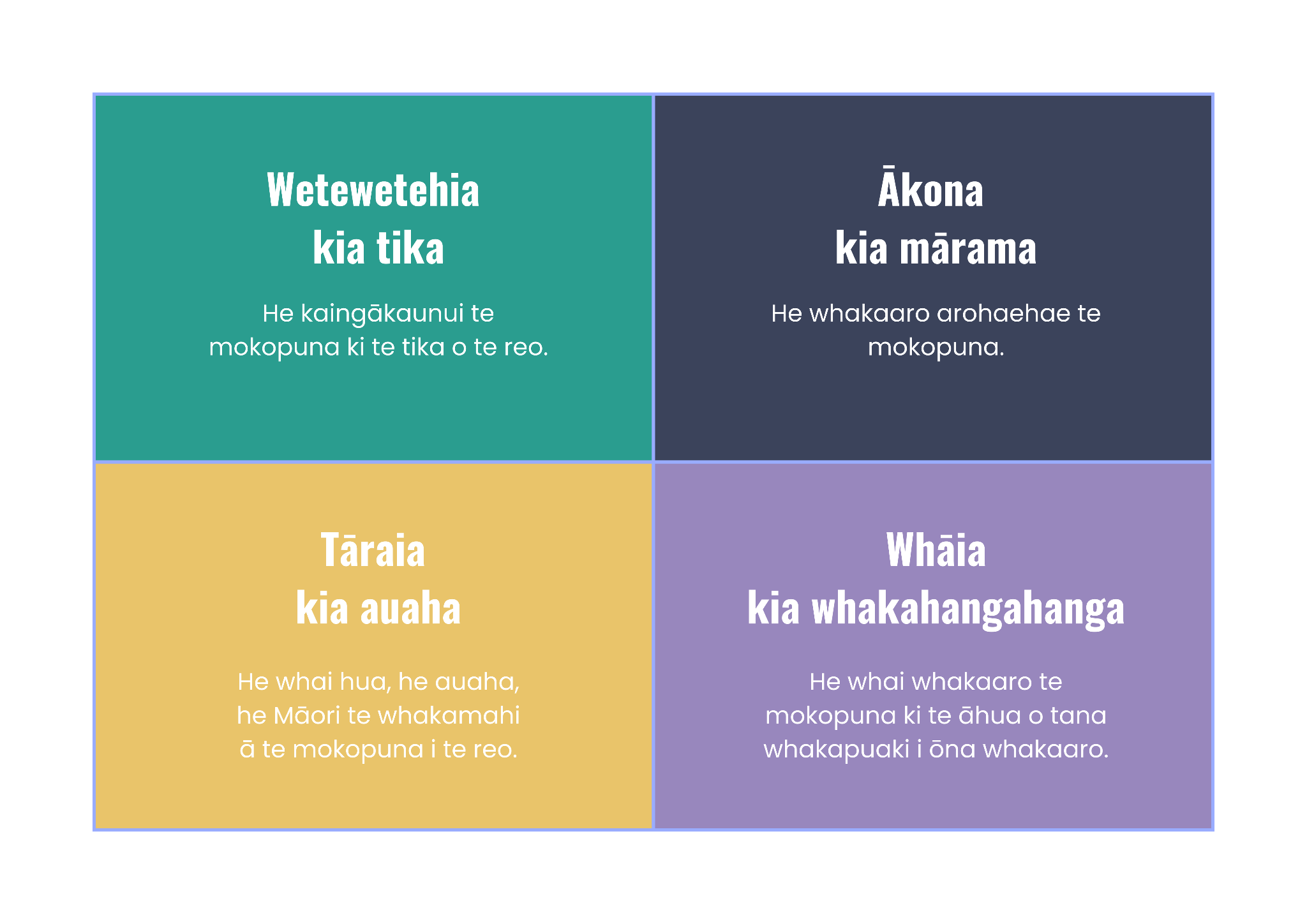
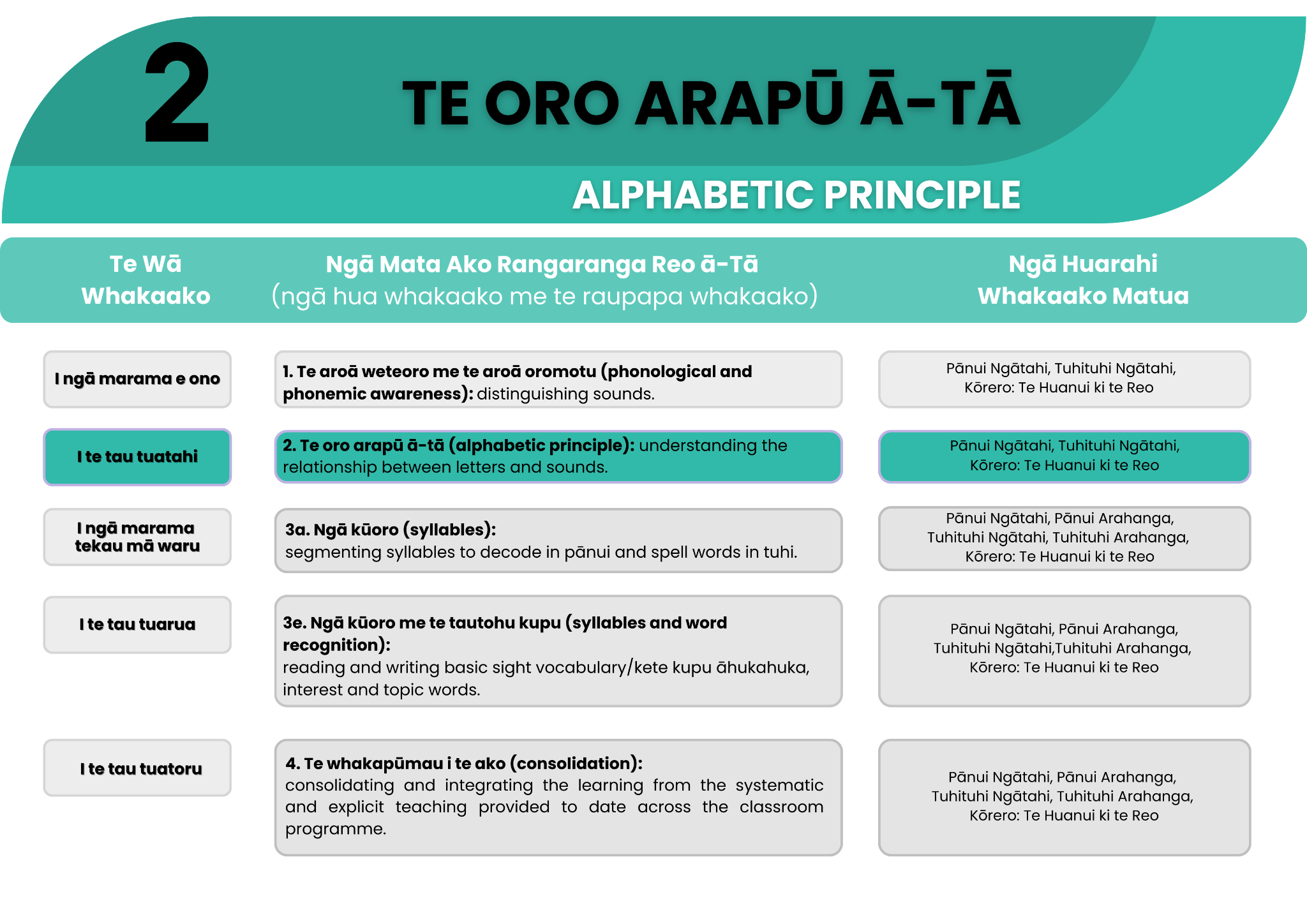
Wetewetehia kia tika
He kaingākaunui te mokopuna ki te tika o te reo.
Te whāinga
Ākonga learning focuses on accurately using and understanding basic vocabulary and sentence structures.
Rangaranga Reo ā-Tā
Ngā Tohu Ako
Te ngako o te whāinga
During a pānui lesson, support ākonga to:
(Rangaranga Reo ā-Tā: Te Oro Arapū ā-Tā) Understand the relationship between letters and sounds
Read from left to right with return sweep.
Locate the beginning and end of sentences.
Use one-to-one correspondence between spoken and written words.
Identify simple conventions e.g. full stops, macrons, and spaces between words.
Use some terms associated with books and print such as tapanga, timatanga, mutunga and tau whārangi.
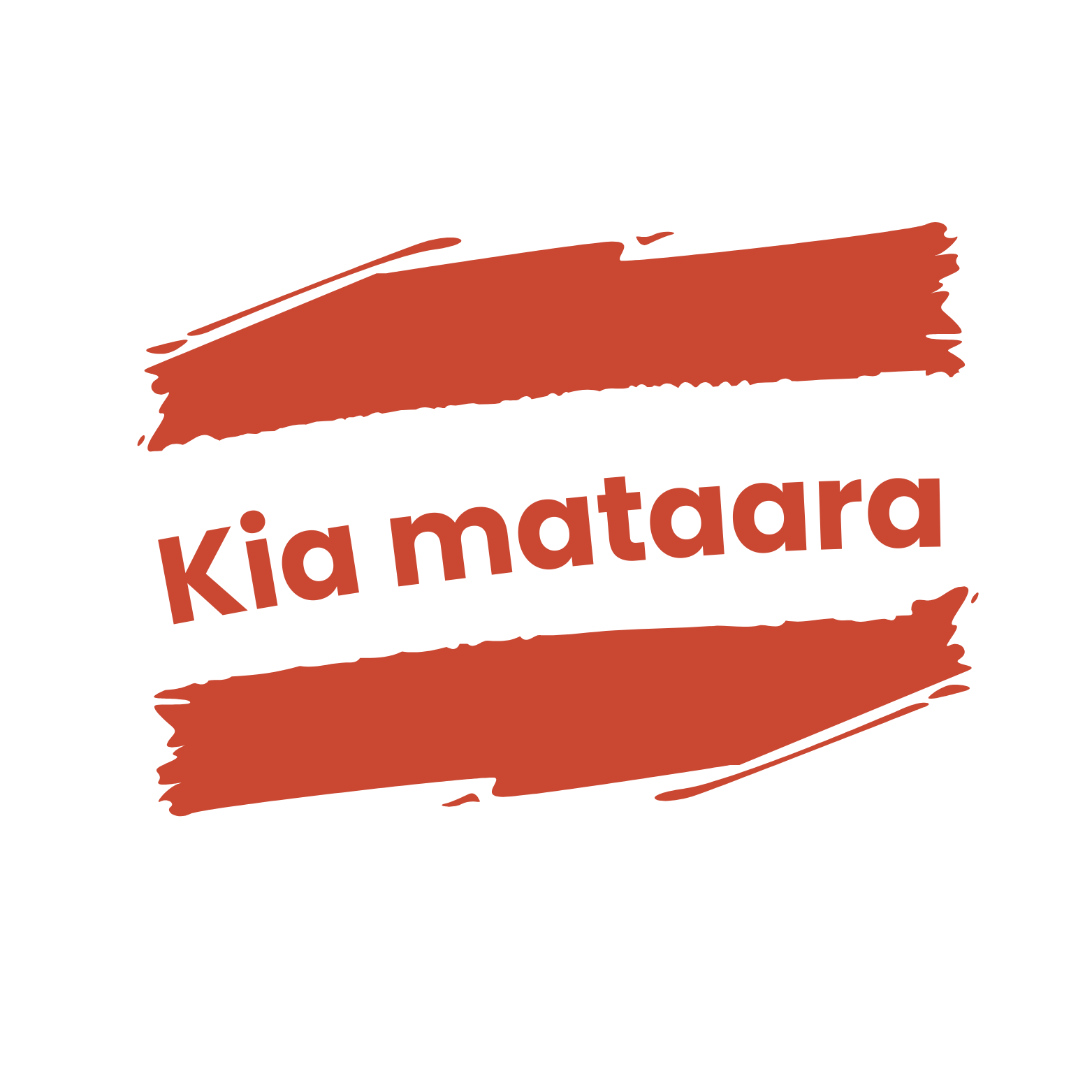
By the end of 1 year at kura, ākonga need to be able to:
make a connection between the phoneme and grapheme during reading, and make a connection between the grapheme and phoneme during writing.
Ākona kia mārama
He whakaaro arohaehae te mokopuna.
Te whāinga
Ākonga learning focuses on developing basic comprehension skills and strategies.
Ngā Tohu Ako
Te ngako o te whāinga
During a pānui lesson, support ākonga to:
Use illustrations, context and the title to predict what a text is about.
Use illustrations to gain meaning.
Acquire new vocabulary from texts shared or read to them.
React when their reading of the text does not make sense.
Connect text to their personal experiences.
Whāia kia whakahangahanga
He whai whakaaro te mokopuna ki te āhua o tana whakapuaki i ōna whakaaro.
Te whāinga
Ākonga learning focuses on developing basic interpersonal communication skills.
Ngā Tohu Ako
Te ngako o te whāinga
During a pānui lesson, support ākonga to:
Respond to questions about a text.
Tāraia kia auaha
He whai hua, he auaha, he Māori te whakamahi a te mokopuna i te reo.
Te whāinga
Ākonga learning focuses on discovering ways to express thoughts and imagination.
Ngā Tohu Ako
Te ngako o te whāinga
During a pānui lesson, support ākonga to:
Offer their own ideas about events described in a text.
I te tau tuatahi: Te Aromatawai i te Pānui
Aromatawai ō te ako (of learning), and aromatawai mō te ako (for learning).
Aromatawai should be personalised to reflect the reality that ākonga are at different stages in their learning journey and move through that journey at different speeds. This includes valuing neurodiversity (i.e. that all brains function differently) which is particularly important for neurodivergent ākonga.
Ākonga should be encouraged and supported to understand the purpose of aromatawai and be active participants in gathering information through aromatawai activities such as self-reflection, self assessment and the creation of portfolios of work that demonstrate their learning.
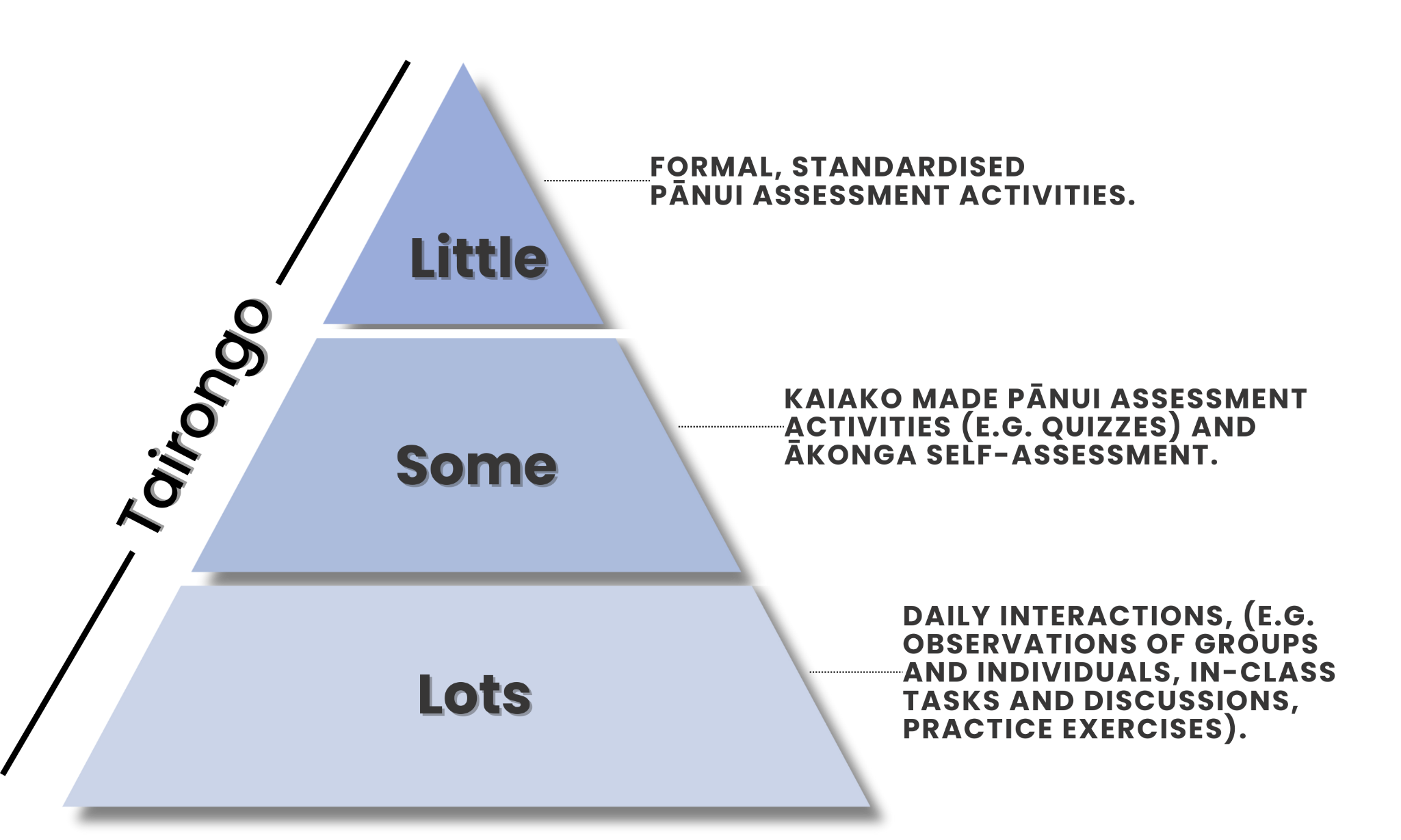
MAHI AROMATAWAI
What to look/listen for, ākonga are:
Choosing to join in on the re-reading of texts used in pānui ngātahi.
Choosing to re-read texts used in pānui ngātahi and pānui arahanga independently.
Using words, phrases and sentences from a text used in pānui ngātahi and or pānui arahanga in their writing and oral language.
Developing consistency of directional behaviours (left to right, return sweep, one-to-one matching of the spoken word to the written word.
Assessment tasks: (currently being trialled).
Te Mōhiohio Pū (Phonics check 1) at 40 weeks
I te tau tuatahi: He Huarahi Pānui Anō
Pānui ki | Reading to:
Involves a kaiako or more skilled reader reading aloud to ākonga.
The focus is on reading in ways that engage the ākonga and foster the love of reading. Ākonga experience expressive and fluent reading as they listen.
Pānui tautokotahi | Reading with:
Involves the kaiako reading at the same time as ākonga during scheduled 'silent reading' times.
The focus is on modelling the value of reading and reading for enjoyment.
Pānui motuhake | Independent reading:
Refers to ākonga reading, viewing and comprehending and enjoying texts on their own.
The focus is on fostering a love of reading. The reader also has the opportunity to practice their knowledge, skills and strategies without direct support from the kaiako.
